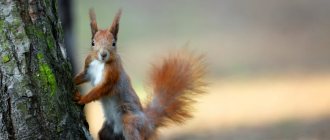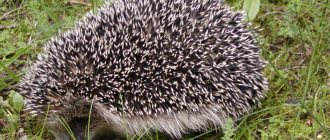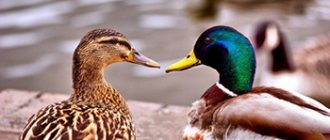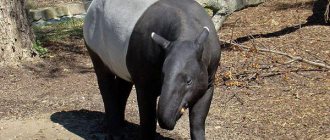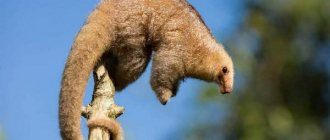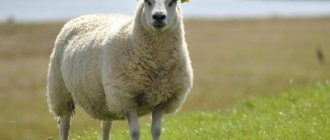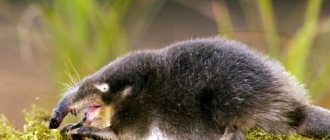- Wild animals
- >>
- Mammals
Such a cute and cute rodent as the prairie dog is increasingly joining the list of pets. This is not surprising, because petting such a charming fluffy is very pleasant, and watching him is even more interesting. Let's try to characterize the prairie dog from different angles, considering not only its external characteristics, but also its disposition, food preferences, places of permanent residence and lifestyle in general.
Origin of the species and description
Photo: Prairie dog
The prairie dog is a rodent belonging to the squirrel family. This family is quite extensive, including animals of various appearance and lifestyle, which are united by a common origin and some identical features of the anatomical structure.
All squirrel relatives are divided into three types:
- wood squirrel;
- flying squirrels;
- ground squirrels.
Ground-dwelling squirrels include prairie dogs, whose name is translated from ancient Greek as “dog-mouse.” Externally, rodents are very similar to marmots and gophers. Then an involuntary question arises: “Why are they called dogs?” It turns out that it's all about the sounds they make, they are reminiscent of a puppy barking.
Scientists identify five species of prairie dogs, so in the vast prairies you can find:
- white-tailed prairie dog;
- Mexican prairie dog;
- Gunnison's prairie dog;
- black-tailed prairie dog;
- Utah prairie dog.
It is almost impossible to immediately determine by external features what type of prairie dog is in front of you, because they are all identical, they are distinguished by some morphological characteristics, for example, the structure and size of the teeth. The differences also lie in the variety of sounds produced, which are different for each species. The tips of the tails of the Mexican and black-tailed dogs are black, while the tips of the other varieties are white. Differences between species also appear in their life activities, but this does not affect external data in any way, so only an experienced and knowledgeable specialist can accurately distinguish between species.
Appearance and features
Photo: Mexican prairie dog
Let us note again that in all its appearance the prairie dog resembles a marmot. Its dimensions vary from 30 to 38 cm, and its weight is from one to one and a half kilograms (sometimes there are heavier specimens). Females are smaller and weigh lighter than males. With such size and weight, the dogs look quite well-fed and have a dense build. Because of this figure, rodents look clumsy. Their body is massive, and their legs and tail are short.
The coloring of these animals can be called camouflage, because it blends perfectly with the surrounding area. The dogs' spine is dirty yellow or yellowish-gray, sometimes with some reddish tint. The abdomen has a lighter tone. The head, in comparison with the general tone of the body, looks darker. The face is decorated with whitish streaks, which are most noticeable on the chin and near the nose.
Video: Prairie Dog
Prairie dogs have a rounded head and a cute muzzle with large, dark, wide-set eyes that tirelessly scan the surroundings. The ears of rodents are so tiny that they are almost invisible under the fur. Dogs have rather large cheek teeth and narrow incisors located on the upper jaw. If necessary, food is loaded into the cheek pouches, like in string bags.
On the short paws of rodents, rather tenacious fingers with long claws, which are very sharp and strong, are visible. The third toe of the front paws stands out forward and is slightly longer than the others. It should be noted that although the legs are short, they are quite powerful, because they are adapted for digging very long underground labyrinths. The soles of prairie dogs' feet are covered with hair. The tail is colored to match the entire body, only in Mexican and black-tailed dogs it has a black tip. Its length can be from 4 to 11 cm.
Where does the prairie dog live?
Photo: Prairie dogs
Prairie dogs have a permanent residence on the territory of the North American continent, or rather, on the vast expanses of its prairies. Rodents occupy an area stretching from the southern part of the province of Saskatchewan, which is located in Canada, and further covers a number of US states.
So, prairie dogs can be found in:
- Kansas;
- Wyoming;
- North and South Dakota;
- Texas;
- Nebraska;
- Utah;
- Montana;
- Oklahoma;
- Colorado;
- New Mexico;
- Arizona.
Prairie dogs have taken a liking to Northern and Central Mexico. They prefer semi-desert and steppe landscapes, where there is no tall vegetation; it is not for nothing that they are called meadow landscapes; the presence of short or medium-sized grass is enough for them. A grassy expanse of arid plains near some water source is an ideal habitat for these squirrels. Dogs try to avoid excessively wet soils and lowlands. Animals were also seen in mountain ranges at an altitude of more than three kilometers. Prairie dogs live collectively in dug burrows, the corridors of which underground form entire labyrinth cities, where there are rooms for various needs.
Interesting fact: The labyrinths of underground tunnels can reach up to 350 meters in length, and go down to 5 meters in depth.
Now you know where the prairie dog lives. Let's see what she eats.
Lifestyle[edit | edit code ]
Prairie dogs live on the prairies of North America. The habitat is dry land covered with short to medium-length grass.
Prairie dogs are active during the day and hide in their self-dug burrows at night. The tunnels are approximately 10 to 15 cm wide and can reach a maximum length of 300 m. They lead to grass-lined nesting chambers located at a depth of 1 to 5 m and approximately 40 cm long. A prairie dog burrow often has only one or two entrances, in rare cases cases up to six.
The white-tailed prairie dog enters a six-month winter hibernation. The black-tailed prairie dog, on the other hand, is active all year round and even moves on snow.
What does a prairie dog eat?
Photo: Prairie dog in nature
Although prairie dogs look very well-fed and slightly clumsy, their menu is dominated by dishes of plant origin. The basis of the dog's diet is grass, but sometimes rodents feast on all kinds of insects, replenishing the supply of protein in the body. When searching for food, prairie dogs do not move far from their burrows.
Rodents snack on:
- flowers;
- seeds;
- foliage;
- buds and shoots of various plants;
- ripened fruits;
- nuts.
In places favored by prairie dogs, the grass becomes noticeably bald, and the soil is clearly visible. The dogs carefully thin out nearby vegetation that may block their view. Due to the fact that dogs act as food competitors to cattle, they often suffer from attacks from farmers who force them out of their inhabited areas in every possible way.
These cute rodents cannot be called thrifty, because... They do not store provisions for future use, and, like many rodents, they do not build pantries. Some species hibernate throughout the winter, and those that are awake eat almost any vegetation that is available during the winter.
In addition to fresh grass, mature prairie dogs living in captivity are treated to:
- nuts;
- vegetables and fruits;
- grain;
- hay.
In autumn, dogs happily eat fallen leaves. Their diet is very similar to that of guinea pigs.
Nutrition
Each clan usually has its own, clearly defined feeding area. But sometimes the “dogs” of different colonies graze together or not far from each other by mutual agreement and agreement. The main food for these animals is grass. In addition, the characteristics of the habitat cannot provide them with much diversity.
But the animals compensate for the lack of proteins by eating numerous prairie insects. The cute fluffy animals graze in droves, and the main sign of their presence is steppe areas that have been heavily plucked and sometimes completely cleared of vegetation by voracious animals. But for the animals themselves, this is only better, because the less grass on their territory, the further the view, and therefore the higher the safety, which they care about with great zeal.
However, such rodents sometimes cause terrible harm to humans through their vital activity. They destroy pastures and thoroughly dig up the land on them, eating cultivated crops. Prairie dogs in the garden can be a real disaster .
Features of character and lifestyle
Photo: Mexican prairie dog
Prairie dogs are social and very sociable animals, living in large colonies that can contain several thousand furry inhabitants. Animals are active during the day, doing not only feeding, but also other daily activities. They, like marmots or gophers, love to stand on their hind legs and monitor their surroundings.
The colony of dogs is divided into families consisting of a pair of males, several females (from 3 to 5) and cubs, ranging from six to thirty pieces. Family ties between dogs are very warm and close; the animals can often be seen sniffing and grooming each other's fur.
Interesting fact: Each family has relative independence, so dogs vigilantly guard their possessions. If a stranger appears, a conflict situation arises. The winner of the dispute can increase his land allotment, but not by more than one meter.
As noted, underground prairie dog sites are very intricate, deep, and extensive. They go down to a depth of three to five meters and are about fifteen centimeters in diameter. The equipped dungeon is very reliable and protected from landslides and flooding.
Interesting fact: In underground labyrinths, all rooms are specialized, some are used as bedrooms, others as birth chambers, others as rescue bunkers from all sorts of ill-wishers.
The dogs even have separately dug latrines, which, when completely filled, are buried with earth and new ones are built. The entire life of these amazing rodents is very thought out and well organized, each one minds his own business, fulfilling the duties assigned to him.
Among the dogs there are:
- guards ensuring the security of the fort;
- builders arranging and digging new corridors and repairing old passages;
- educators who train young animals and instill in them the necessary life skills.
In general, prairie dogs have very close contact with each other, showing sociability and good nature. They have a well-developed system of various sound and gesture signals designed for various situations. They can be described as peaceful, friendly and caring creatures with close family ties.
Interesting fact: The ritual of the so-called “kiss” speaks about trust in family relationships, when the closest relatives touch with open mouths as a sign of love and respect.
The black-tailed prairie dog is awake all year round; it does not hibernate; it actively moves even in the snow. The remaining dogs are in a state of winter suspended animation from the end of August to March, so they actively gain weight before hibernation.
Literature[edit | edit code]
- Ronald M. Nowak: Walker's Mammals of the World
. Johns Hopkins University Press, Baltimore/London 1999. ISBN 0-8018-5789-9 - John L. Hoogland: The Black-Tailed Prairie Dog: Social Life of a Burrowing Mammal
. University Press, Chicago 1995. ISBN 0-226-35118-1 - Christian Ehrlich: Präriehunde, Biologie, Haltung, Zucht
. Natur- und Tier, Münster 2004. ISBN 3-931587-97-5 - John L. Hoogland: Conservation of the Black-Tailed Prairie Dog, Saving North Americas Western Grasslands
. Island Press, Washington DC 2005. ISBN 1-55963-498-7
Social structure and reproduction
Photo: Prairie Dog Family
Little is known about the reproduction of prairie dogs. They become sexually mature closer to the age of three. The wedding season for these rodents occurs once a year, and if fertilization is successful, then the parents have offspring. The duration of pregnancy is from 28 to 32 days, childbirth usually occurs in the spring (April - May).
The number of newborns varies from two to ten babies. They are born completely helpless, naked and blind. A little more than a month later, they begin to see clearly. At seven weeks of age, babies gain independence and begin to make forays out of their burrow. During this same period, they stop feeding on their mother’s milk and switch to a plant-based diet.
Interesting fact: In dogs, mature individuals often leave their homes, leaving them for the young to live in, and they build new burrows nearby for themselves. This suggests that animals are very caring.
It is worth noting that older males form their own families, and young females often remain to live in the parental clan. Under natural conditions, prairie dogs do not live very long. Males are usually no more than five years old, while females live up to eight years. Tamed prairie dogs can live 11 years, because in captivity the environment is always favorable, and there are no external threats of any kind.
Natural enemies of prairie dogs
Photo: Prairie dog
Peaceful prairie dogs are susceptible to attacks by various predators, both ground-based and feathered, carrying out air attacks. It’s not for nothing that these smart rodents chose to live in a collective environment, because it’s much easier to live this way in harsh wild conditions, where danger can lurk everywhere. Security dogs are constantly vigilant, constantly monitoring their surroundings in order to identify all kinds of threats that may come from:
- badgers;
- black-footed ferrets;
- coyotes;
- Mexican falcons;
- hawks;
- cave owls
A developed communication network among prairie dogs helps them not only communicate with each other, but also survive in various emergency situations. Smart dogs, with their voices and postures, not only report impending danger, but also clarify who exactly it is coming from, from which side the enemy is approaching, and how he does it. As a result of this alert, protective actions may vary depending on what kind of enemy is approaching (badger, hawk or coyote). Dogs can quickly hide, but be close to the exit from the hole, they can go deep underground, they can only move closer to the entrance to the hole.
Interesting fact: Zoological scientists compare prairie dogs with dolphins and primates due to their highly developed level of communication.
Danger to prairie dogs can also come from creeping reptiles. There is evidence that often undigested remains of these rodents were found in the stomachs of rattlesnakes.
Sadly, the worst enemy of prairie dogs is man, who exterminated the once vast populations of these squirrels. Farmers killed a huge number of prairie dogs, which, in their opinion, ate fields intended for grazing livestock. All this led to the fact that the number of animals became many times smaller, which is very sad to realize.
How to get rid
The biggest mistake of American landowners was an attempt to exterminate “dogs”, like ordinary rodents, with chemicals. But these are not mice, but smarter creatures. They are able to recognize baits laid out everywhere in the form of poisoned food. They avoid the placed traps and traps.
Actions to spray harmful substances from the air turned out to be even more unwise. Colonies of these animals are very numerous and are located deep underground. It is impossible to completely eradicate them in this way. At the same time, enormous damage was caused to the environment with little result. Attempts to contaminate water in the area with chemicals led to similar sad consequences.
Catching “dogs”, taking into account the size of their colony, is also useless. However, there is still a way to expel unpleasant rodents from your territory, and it is safe for nature and humans. It was the ultrasonic ones that scared them away.
The waves they emit force the “dogs” to move away from valuable land plots. And this happens with a high degree of probability and in a fairly short time. These are modern environmentally friendly means.
Population and species status
Photo: Couple of prairie dogs
To trace changes in the prairie dog population in more detail, let's look at history. White settlers who appeared on the American prairies in the nineteenth century exterminated a considerable number of animals belonging to the local fauna. Then, many predators hunting prairie dogs died at the hands of people, which caused a huge leap in the direction of increasing the population of these rodents.
There is evidence that at the beginning of the last century, in an area of 1000 square kilometers, there were about one hundred million prairie dogs, which actively began to devastate cultivated fields and pastures. Farmers began to wage a fierce fight against rodents, destroying them in huge quantities, which greatly reduced their population and brought the animals to the brink of extinction.
Interesting fact: There is reliable data that is simply shocking, according to them, in 1905, the population of prairie dogs living in the vast expanses of Texas numbered approximately 800 million individuals, but at the end of the century there were only 2.2 million of them left!
So, the population of prairie dogs has decreased greatly due to barbaric human actions, and now its numbers gradually continue to decline, which is very worrying for many environmental organizations that are taking measures to save these amazing animals.
Interesting Facts
prairie dogs in Russia, in particular in Siberia . There were enough messages about this on the Internet. But such facts were not confirmed during their investigation. As it turned out, other large rodents were simply confused with the “dogs,” which are found exclusively in the steppes of North America.
And in Russian territories, due to their biological characteristics, the heat-loving animals we have just described simply could not survive, even if we assume that they were brought to these regions by chance or on purpose. That's all. This could be the end of the story about small furry animals. But let’s add some facts to all of the above:
- Prairie dogs are naturally endowed with very acute vision. And therefore, vigilant animals, in order to examine the surroundings, only slightly stick out the tops of their heads from the hole. This is enough for them to see everything they need;
- Powerful organs of touch for our mouse-dogs are special receptors located in abundance on the surfaces of their palms and tongue;
- Such rodents have 22 sharp teeth, but there are no fangs among them, but there are molars, small molars and incisors;
- It has already been mentioned that “dogs” warn their relatives of danger with a characteristic bark. But besides this, these animals have a fairly developed language of communication for other cases. In particular, there are special signals that indicate the presence of an existing host in a certain area;
- With the arrival of cold weather, the “dogs’” body plunges into a special state when energy consumption is extremely reduced and body temperature drops by several degrees. But in severe frosts they plunge into torpor;
- Prairie dogs, as a biological genus, are divided not only into species, but also into two groups. Representatives of the first of them have a black tail end and eight nipples. And the second group includes animals whose tail is white at the end. They have ten nipples.
Often rodents, inhabitants of the American steppes, are also confused with Chinese dogs. These are also rodents, but outwardly they are completely different from them. The similarity is only in the name. Chinese dogs do not live in China at all, but are found here. They are smaller in size, look like rats and are notorious pests. They destroy crops and gnaw tree bark.
